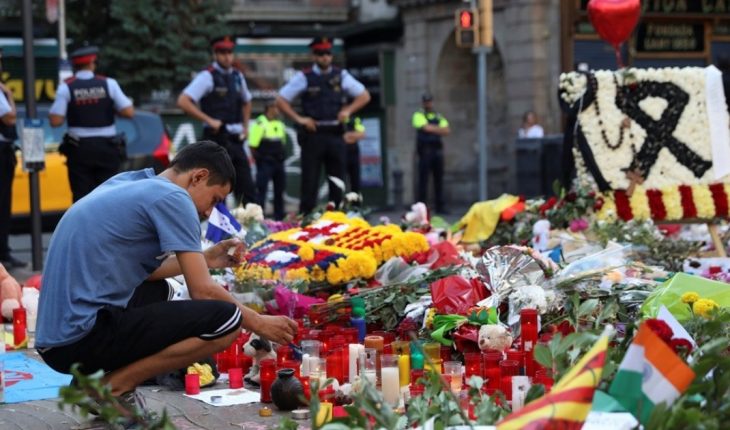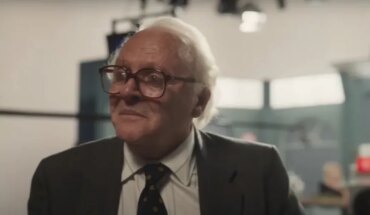On August 17, 2017 Pablo Abecasis, born and raised in Ramos Mejía, attended one of the magazine kiosks of La Rambla de Catalunya when he heard noises and looked to see what was going on. He immediately discovered the van that minutes earlier he had entered the pedestrian path and was pointing towards the business. Many pedestrians had not taken note of the suspicious presence. Paul looked inside the place and saw some children playing outside the situation. He didn’t have time to warn them. The van accelerated and Paul started running.
“At any moment something was going to happen. We knew that. I wanted to get into the business, but a man pushed me out. I didn’t have any more time,” Paul tells Filo.News, three years into the day that changed his life forever.
The van faced the post straight. He rolled the shelves of books and magazines. Paul prepared for impact with both hands and one leg in the air. The van scrambled him through the air. Paul fell from his back to the ground. His friends ran to see if he was alive. They thought he was dead and started screaming. Paul sat down but couldn’t talk because his jaw was stuck. Meanwhile, the van was stuck with what it had destroyed. Lives, of all ages and sexes. No distinction of races. The driver, young Moroccan Younes Abouyaaquob, accelerated and accelerated until the wheels were unlocked and the work continued. A woman was running away with her child in the cart. They both flew through the air. “The boy,” Paul recalls, “fell dead into my friend’s arms.” While Abouyaaquob was spreading bodies and hatred, Paul crawled inside the hotel where his friends had moved him by the beatings. A policeman found him on the floor and told him to cover himself, because there was a chance there was a bomb.” I thought if the bomb went off, the crystals were going to destroy me. I crawled to the elevator and touched the button on the first floor. I went upstairs and when the door opened on the first floor, I was helped by the employees who knew me because I was carrying magazines to the hotel’s customers,” he says. Paul was in shock. No ambulance was taking him to the hospital because there were so many dead and seriously injured. No doctor checked it. Sirens, alarms, paramedics, screams. The whole city was on alarm. Then his friends loaded him into a taxi and took him to the guard. Doctors evaluated him and told him to rest. That there were no major injuries to the sight. But terror was already nailed to the bones.” In my house, he confesses, I began to fall from what had happened. But what came next was worse.” Never again. Paul went 10 months out of work. He was never the same person again. He used to be kind, friendly, sociable. Now he suffers from panic and anxiety attacks. You can’t go near the attacking area. Sometimes he tries to get back to the routine. To the places I used to travel. He dresses, prepares mentally and leaves the apartment. He respects the mind map he traces to feel safe in the city that received him in 2013, when he arrived from Italy. He’s trying. Strives. But he can’t. Then find a bar, choose a chair. He sits down to breathe as recommended by the psychologist. But he never makes it.” I got better, but I got kicked out of the job, and now I’m waiting for trial with two herniated discs and injured cervical vertebrals. I am not the same man with his broken voice.” Know death first hand, without intermediaries. Falling into the clutches of terrorism leaves a mark that goes beyond the physical. It’s a state of mind that traps victims and leaves them helpless with their memories. Never be the same again. Never again. The curse of the survivors, who feel guilt and frustration. Lourdes Fernández is an expert psychologist on the victims of terrorist attacks. In dialogue with Filo, the Catalan specialist explains that “people who go through attacks the first thing they lose is security in the environment and in themselves. Fear is atrocious. A white van, which here in Spain are common, becomes a lion, an object of danger. Like it’s a gun in your everyday life.” The terrorist target was not only the physical impact but to leave a mark on the emotional memory of the city. Carve with terror, the before and after one of the most visited tourist destinations in the world. For Fernandez, the terrorists “marked a milestone in the city. Now we all remember what we were doing on 17 A.What is a terrorist looking for?
The intentionality of provoking fear. An accident is casual, an attack is causal. Paul is more afraid of a van than a dangerous animal. It has the emotional imprint of terrorists on his mind forever. They’re looking for you never to feel safe again. That you live in the uncertainty of not knowing cusomething bad can happen to you. Many victims point out that the Spanish state did not accompany them as expected. Does this demand for protection arise in therapy? Victims have a double victimization. On the one hand, they are physical and emotional victims of the attack. Then there is a revictimization because the system does not understand how to treat them. The system tries to solve it quickly, give partial support. The discomfort to the victim lasts a long time, how to continue after such a shock?
When the wounds incompatible with life end, the wounds incompatible with living remain. They recover from physical wounds but not from emotional ones. You wonder why they survived and feel guilt, does survivor’s syndrome show up?
They feel guilty because they survived. The worst judge we have is ourselves. Paul is assisted by associations of bombing victims. There he finds testimonies from different eras of a country crossed by violence. As Fernandez explained, the judicial process and the treatment of society towards victims generates anger and anger towards life. And it opens the window to the paradox of feeling more resentment toward those who should help and not those who caused the harm.” That feeling, Fernandez explains, is set for the state, rather than terrorists. They have a grudge against not receiving the expected support.” Future. The investigation of the case brought certainties about the Moroccan cell that spread terror on 17 a.The group planned to attack the Camp Nou, in addition to the Sagrada Família, also in Barcelona, and the Eiffel Tower, in Paris. But on the night of 16 August, three of the terrorists suffered a fatal accident in the chalet of the Catalan municipality of Alcanar where they prepared the explosives and the plans were altered. Among them was Abdelbaki Es Satty, Ripoll’s Imam and cell leader. This man had already been detected by the Spanish intelligence services but did not perceive it as the threat that eventually became the brain of the lion who bit Barcelona a day later. Because of this explosion, the rest of the cell decided that the young Younes Abouyaaqoub would attack La Rambla with one van while five others traveled to Cambrils, another Catalan municipality, where several people were shot, before falling under the bullets of the Mossos d’Esquadra. That day in Barcelona 16 people died and about 140 were injured in total. Others, like Paul, were wounded with life. Waiting for justice that may never come.
translated from Spanish: The horror in first person: 3 years after the Barcelona bombing
August 17, 2020 |





